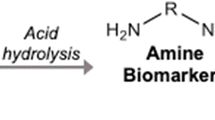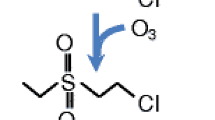Summary
Five men were exposed to toluene diisocyanate (TDI) atmospheres for 7.5 h. The TDI atmospheres were generated by a gas-phase permeation method, and the exposures were performed in an 8-m3 stainless-steel test chamber. The mean air concentration of TDI was ca. 40 μg/m3, which corresponds to the threshold limit value (TLV) of Sweden. The inhaled doses of 2,4- and 2,6-TDI were ca. 120 μg. TDI in the test chamber air was determined by an HPLC method using the 9-(N-methyl-aminomethyl)-anthracene reagent and by a continuous-monitoring filter-tape instrument. After hydrolysis of plasma and urine, the related amines, 2,4- and 2,6-toluenediamine 2,4-, and 2,6-TDA), were determined as pentafluoropropionic anhydride (PFPA) derivatives by capillary gas-chromatography using selected ion monitoring (SIM) in the electron-impact mode. The urinary elimination of the TDAs showed a possible biphasic pattern, with rapid first phases for 2,4-TDA (mean t 1/2 for the concentration in urine, 1.9 h) and for 2,6-TDA (mean t 1/2 for the concentration in urine, 1.6 h). The cumulative amount of 2,4-TDA excreted in urine within 28 h ranged from 8% to 14% of the estimated dose of 2,4-TDI, and the cumulative amount of 2,6-TDA in urine ranged from 14% to 18% of the 2,6-TDI dose. The average urinary level of 2,4-TDA was 5 μg/l in the 6 to 8-h sample (range 2.8–9.6 μg/l), and the corresponding value for 2,6-TDA was 8.6 μg/l (range, 5.6–16.6 μg/l). Biological monitoring of exposure to 2,4- and 2,6-TDI by analysis of 2,4- and 2,6-TDA in urine is feasible.
Similar content being viewed by others
References
Berode M, Leuenberger Ph, Savolainen H (1988) Phenotype-dependant inhibition of α1-antitrypsin by 1,6-hexane diamine in vitro. Biochem Int 17:141–145
Brorson T, Skarping G, Renman L, Sangö C (1989) Test atmospheres of diisocyanates with special reference to controlled exposure of humans. Int Arch Occup Environ Health 61:495–510
Brorson T, Sangö C, Skarping G, Renman L (1990a) Evaluation of chromatographic methods for the determination of isocyanates in air. Int J Environ Anal Chem 38:399–413
Brorson T, Skarping G, Nielsen J (1990b) Biological monitoring of diisocyanates and related amines: II. Test chamber exposure of humans to 1,6-hexamethylene diisocyanate (HDI). Int Arch Occup Environ Health 62:385–389
Brown EW, Green AH, Karol MH, Alarie YCE (1982) Inhibition of cholin-esterase activity by isocyanates. Toxicol Appl Pharmacol 63:45–52
Chester EH, Martinez-Catinchi FL, Schwartz HJ, Horowitz H, Fleming GH, Gerblich AA, McDonald EW, Brethauer R (1979) Pattern of airway reactivity to asthma produced by exposure to toluene diisocyanate. Chest 75:229–231
Dalene M, Skarping G, Brorson T (1990) Chromatographic determination of amines in biological fluids with special reference to the biological monitoring of isocyanates and amines: IV. Determination of 1,6-hexamethylene diamine (HDA) in human urine using capillary gas chromatography and selective ion monitoring. J Chromatogr 516:405–413
Glinsukon T, Benjamin T, Grantham PH, Weisburger EK, Roller PP (1975) Enzymatic N-acetylation of 2,4-toluenediamine by liver cytosols from various species. Xenobiotica 5:475–483
Grantham PH, Mohan L, Benjamin T, Roller PP, Miller JR, Weisburger EK (1980) Comparison of the metabolism of 2,4-toluenediamine in rats and mice. J Environ Pathol Toxicol 3:149–166
Hagmar L, Nielsen J, Skerfving S (1987) Clinical features and epidemiology of occupational obstructive respiratory disease caused by small molecular weight organic chemicals. Monogr Allergy 21:42–58
Hanson A, Melander A, Wåhlin-Boll E (1981) Acetylator phenotyping: a comparison of the isoniazid and dapsone tests. Eur J Clin Pharmacol 20:223–234
Karol MH (1983) Concentration-dependent immunologic response to toluene diisocyanate (TDI) following inhalation exposure. Toxicol App Pharmacol 68:229–241
Marzulli FN, Anjo DM, Maibach HI (1981) In vivo skin penetration studies of 2,4-toluenediamine, 2,4-diaminoanisole, 2-nitro-p-phenylenediamine, p-dioxane and n-nitrosodiethanolamine in cosmetics. Food Cosmet Toxicol 19:743
Rando RJ, Abdel-Kader H, Hammad YY (1984) Isomeric composition of airborne TDI in the polyurethane industry. Am Ind Hyg Assoc J 45:199–203
Rosenberg C, Savolainen H (1985) Detection of urinary amine metabolites in toluene diisocyanate exposed rats. J Chromatogr 323:429–433
Rosenberg C, Savolainen H (1986a) Determination of occupational exposure to toluene diisocyanate by biological monitoring. J Chromatogr 367:385–392
Rosenberg C, Savolainen H (1986b) Determination in urine of diisocyanate-derived amines from occupational exposure by gas chromatography-mass fragmentography. Analyst 111:1069–1071
Sandström JF, Skarping G, Dalene M (1989) Chromatographic determination of amines in biological fluids with special reference to the biological monitoring of isocyanates and amines: II. Determination of 2,4- and 2,6-toluenediamine in human urine using capillary gas chromatography and selected ion monitoring with special reference to the biological monitoring of exposure to toluene diisocyanates. J Chromatogr 479:135–143
Sangö C, Zimerson E (1980) A new reagent for determination of isocyanates in working atmospheres by HPLC using UV or fluoroscence detection. J Liquid Chromatogr 3:971–990
Skarping G, Renman L, Sangö C, Mathiasson L, Dalene M (1985) Capillary gas chromatographic method for the determination of complex mixtures of isocyanates and amines. J Chromatogr 346:191–204
Skarping G, Dalene M, Brorson T, Sandström JF, Sangö C, Tiljander A (1989) Chromatographic determination of amines in biological fluids with special reference to the biological monitoring of isocyanates and amines: I. Determination of 1,6-hexamethylenediamine using glass capillary gas chromatography and thermionic specific detection. J Chromatogr 479:125–133
Tiljander A, Skarping G, Dalene M (1989) Chromatographic determination of amines in biological fluids with special reference to the biological monitoring of isocyanates and amines: III. Determination of 4,4′-methylenedianiline in hydrolysed human urine using derivatization and capillary gas chromatography with selected ion monitoring. J Chromatogr 479:145–152
Unger PD, Salemo AJ, Ness WC, Friedman MA (1980) Tissue distribution and excretion of 2,4-[l4C]-toluenediamine in the mouse. J Toxicol Environ Health 6:107–114
Waring RH, Pheasant AE (1976) Some phenolic metabolites of 2,4-diaminotoluene in the rabbit, rat and guinea-pig. Xenobiotica 6:257–262
Welinder H, Nielsen J, Bensryd I, Skerfving S (1988) IgG antibodies against polyisocyanates in car painters. Clin Allergy 18:85–93
WHO (1987) Environmental health criteria 75. Toluene diisocyanates. World Health Organisation, Geneva
Author information
Authors and Affiliations
Rights and permissions
About this article
Cite this article
Skarping, G., Brorson, T. & Sangö, C. Biological monitoring of isocyanates and related amines. Int. Arch Occup Environ Heath 63, 83–88 (1991). https://doi.org/10.1007/BF00379069
Received:
Accepted:
Issue Date:
DOI: https://doi.org/10.1007/BF00379069




